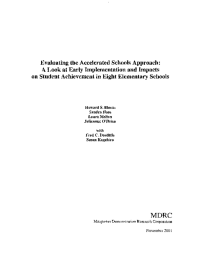Evaluating the Accelerated Schools Approach
A Look at Early Implementation and Impacts on Student Achievement in Eight Elementary Schools
A key challenge faced by elementary schools is finding effective ways to help all students develop the skills needed to succeed in later education and the labor market. Remedial education programs have been a traditional response to academic problems, especially among poor and minority students, but past research has shown that this approach can keep students from joining the educational mainstream. The Accelerated Schools approach charts a different course, seeking to “accelerate” rather than slow down the learning of children at risk of school failure.
Developed by Dr. Henry M. Levin and his colleagues at the Accelerated Schools Project (ASP), the Accelerated Schools model is now being used in more than 1,000 elementary and middle schools. Accelerated Schools seek to (1) create a new, supportive school culture that sets high expectations for teachers and students; (2) institute a governance structure characterized by broad staff participation in decision making and by procedures for taking stock of the school’s strengths and problems and for generating solutions; and (3) introduce a “powerful learning” approach to curriculum and instruction that is more challenging, interactive, project-based, and relevant for students than traditional approaches.
At ASP’s invitation and with funding from the Ford Foundation, MDRC conducted an independent evaluation of the Accelerated Schools reform in eight elementary schools around the country. The schools selected by the research team served a high proportion of at-risk students, had implemented the early version of the reform’s main components by the early 1990s, did not institute other major reforms during the study period, and were able to supply the requisite data. In the study’s “interrupted time series” design, the schools’ third-grade test scores in reading and math during the three years before the reform was launched were used to predict what the third-grade test scores would have been without the reform during each of the five following years. To estimate impacts on student achievement, the predicted test scores were then compared with the actual scores. The study focused on successive cohorts of third-graders because this grade marks a critical point in the development of basic reading and math skills.
Among the study’s key findings:
- During the first three years of implementation, the schools focused on reforming school governance and culture, turning to curriculum and instruction only in the third or fourth year.
- The reform’s impacts on third-grade test scores tracked schools’ implementation of it. There were no positive impacts in the first two years, a slight decline in the third year — as schools began to modify their curriculum and instruction — and a gradual increase in the fourth and fifth years. The average third-grade reading and math scores in the fifth year exceeded the predicted levels by a statistically significant amount.
- These impacts were not uniform across all students or all schools. The largest impacts were observed among students who would have scored in the middle of their school's test score distribution without the reform and among the schools that had the lowest test scores before launching the reform.
These results should be interpreted with caution for several reasons: They are based on a sample of only eight schools, the positive impacts took four to five years to emerge, and it is not known whether the impacts will persist in later grades. Nevertheless, these findings show that the Accelerated Schools approach improved academic achievement in a group of mostly at-risk students.






